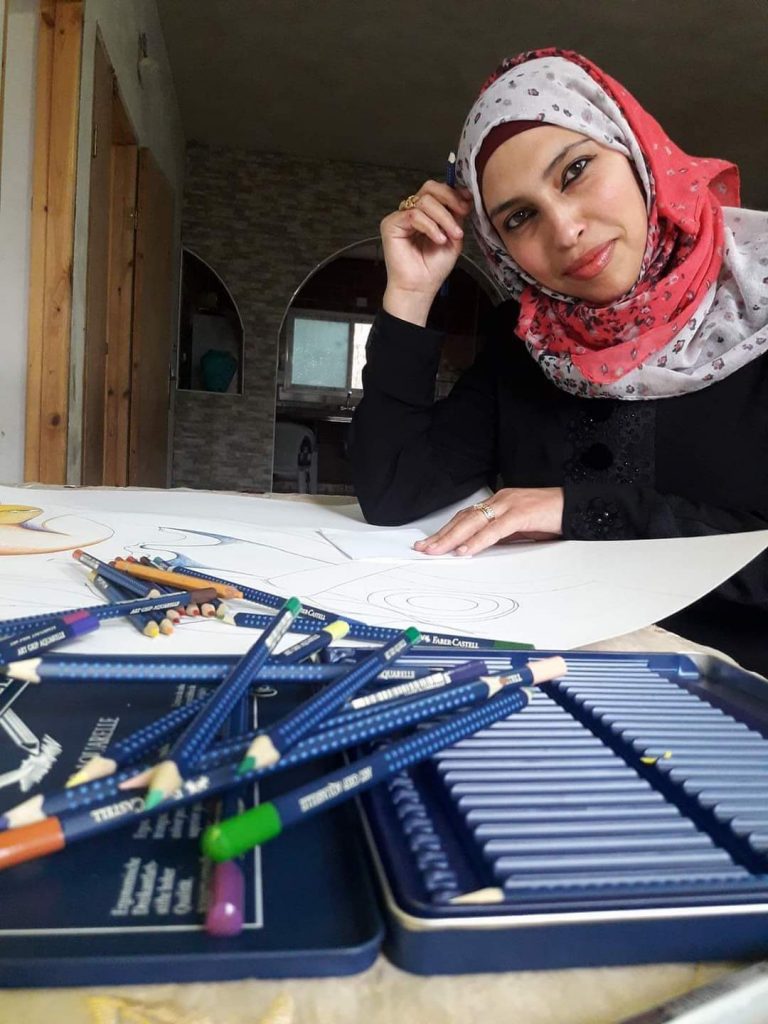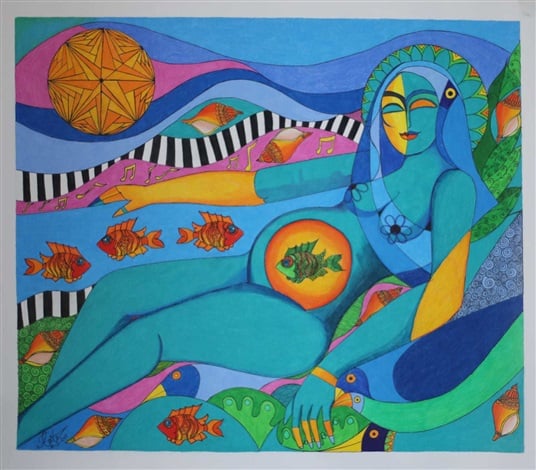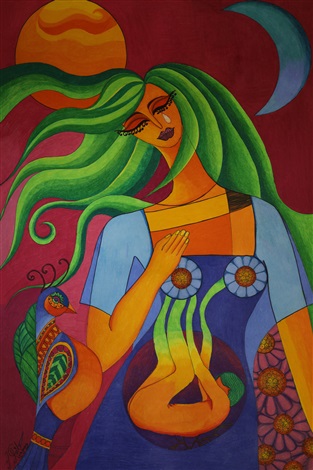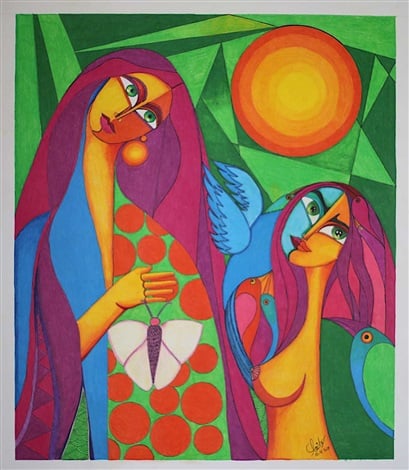How Laila Kassab, Born in a Gaza Refugee Camp, Defied the Odds to Become an Artist and Teach Children in War-Torn Communities


Artnet Gallery Network

Laila Kassab (b. 1985) tried not to become an artist—but it didn’t go well.
Kassab, who is Palestinian, and a mother of four children, was raised in Gaza’s Rafah refugee camp and has made art since childhood. Being an artist professionally, however, was not an idea she fully allowed to form even as a daydream. She attended Al Aqsa University in Gaza, earning a degree in psychology, and then started a career pursuing social work.
But something was missing. Kassab only felt at peace while creating her artworks—colorful scenes of women in kaleidoscopic worlds filled with doves, fish, and swirling flowers, all of which contrasted with her own surroundings.
“I felt suffocated otherwise,” she said, “Women’s dreams are not encouraged here.”
Kassab decided she needed to make a change, and, much to the confusion of everyone she knew, she committed herself to making art full time.
Today, working as an artist in Gaza, Kassab’s opportunities are limited, but in the past few years, she has collaborated and exhibited with the Rebuilding Alliance, a nonprofit organization that works in war-torn communities to provide citizens with opportunities for engagement and to help rebuild their neighborhoods.
Through Rebuilding Alliance, Kassab has had the opportunity to exhibit her works in the U.K., though she was banned from traveling to the exhibition. During the recent lockdowns, Kassab has worked with Rebuilding Alliance to host outdoor art classes for children.
We spoke with Kassab to learn about her journey to becoming an artist, and her hopes for the future.

Laila Kassab, Sea Music, Another Secret. Courtesy of the Rebuilding Alliance.
Can you tell me a bit about yourself and how you started making art?
My interest in drawing started in childhood. I used to spend a lot of time on graffiti with charcoal and I liked to play with clay and shape it. My childhood was otherwise miserable, full of family problems and violence. The traumas of that childhood kept me locked in my fears for perhaps 12 years. I can only explain it as though I was an old woman locked in in the body of a child, and I was withdrawn and afraid. My middle school drawing teacher encouraged me to break these fears and start my life over. As a student, I participated in many technical art competitions and worked to get first place every time. But when it came to university, my father refused to let me study fine arts. He preferred for me to study sociology instead. So began another four years that I lived with something I didn’t like.
My real breakthrough came when I secretly volunteered in one of the institutions that support beginning artists. There, I learned painting, sculpture, and a lot of other arts. When my father found out, he forbade me to go. I locked myself in my room and abstained from eating and drinking. And when he sensed I wouldn’t change my mind, I was allowed to go, on the condition that it did not affect my university studies.

Laila Kassab, My Dreams Will Never Die. Courtesy of the Rebuilding Alliance.
After earning a degree in psychology and then working as a social worker, you ultimately returned to art. How did you manage to do that?
After finishing my university studies I worked as a psychologist in a government clinic. I was only able to draw in my spare time and rarely had time for painting. I felt suffocated again. I asked myself, “Why do I always do things that I do not like?” The question was like a smack to the face. I decided to quit work and doing everything I didn’t like—I was drawing full-time only. But leaving work was a difficult step because I was then without a monthly salary to meet my needs. I decided to make art pieces from environmental materials, had them included in some exhibitions, which allowed me to buy the supplies to continue painting. I got to know some friends from Britain, France, and the U.S., who smuggled my artworks out of the Gaza siege so that my paintings could see the light of day in European and American countries.
You’ve been teaching an art class to children outside during the past year. Can you tell me about that?
The idea first started after the war in 2014. There was a lot of destruction around and children were shivering in fear of what could happen next. I picked up these kids and did a home art class to try to help alleviate their suffering and to help them express their fears. We had to stop the class for a few years because of resources, but now the Rebuilding Alliance is supporting the classes as a way to try to bring happiness to children during the pandemic. Of course, before starting to teach children different types of arts, we protect them, distribute masks, sterilize, and talk about the importance of caring for personal hygiene, washing hands, not shaking hands, and social distancing. The children were very happy to have the interaction and they all made great progress during these classes.
What has joining and working with the Rebuilding Alliance been like?
It was a new beginning, too. The Rebuilding Alliance brought together a group of male and female artists and the organization was able to display our paintings together in wonderful exhibitions outside of Gaza. This offered us many opportunities. Last year the Rebuilding Alliance showed and auctioned some of our works in the U.S., which is of course a chance to draw worldwide attention to our causes, our lives, and our work.
You support your family, take care of your children, and make art. How do you manage this?
Today, I consider art my way of defending myself. I am a working woman, but without leaving the house. I set up a home art classroom where I work with children four days a week. In the remaining days, I take care of my children and teach them, in addition to housework. Motherhood is a very difficult thing. I paint at night after my children sleep and when I can be alone to draw.

Laila Kassab, Broken Wings. Courtesy of the Rebuilding Alliance.
Who are some artists you admire?
I love the works of the Palestinian artists Kamel Al-Mughni and Tamam Al-Akhal.
What are your hopes for the future?
I’d like to attend some of exhibitions that I participate in. I hope to travel to America—I know this is difficult, but probably not impossible. I’d like to visit the Foundation for Rebuilding Alliance, in Redwood City, California, and to visit the Palestinian Museum in Connecticut. I’d love to interview the museum’s founder, Faisal Saleh. He seems like a very cool man. And I hope to meet Oprah Winfrey because she’s inspired me so much!
